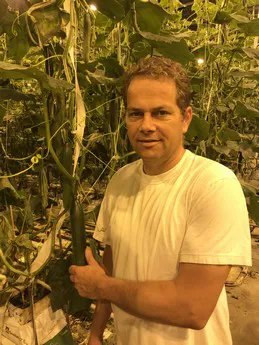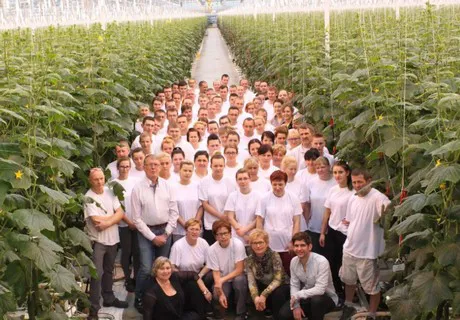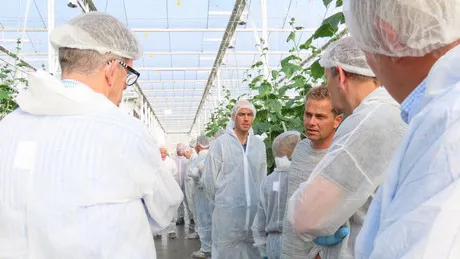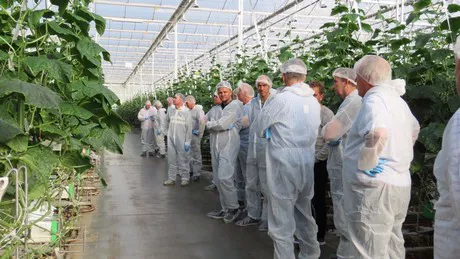“ We have three selection criteria when we have to choose a variety. The first is virus resistance, second is virus resistance and third is, I am sure you can guess,” says Marcel Huibers, cultivation manager / general manager at Dutch cucumber nursery Hortus in Futuro in Maasbree, laughing. In recent years the company has always had problems with the cucumber mosaic virus and therefore decided this year to plant the Nunhems Hi Light variety in summer on ten hectares on the high wire. "The variety is the solution for growers with virus problems."
We have three selection criteria when we have to choose a variety. The first is virus resistance, second is virus resistance and third is, I am sure you can guess,” says Marcel Huibers, cultivation manager / general manager at Dutch cucumber nursery Hortus in Futuro in Maasbree, laughing. In recent years the company has always had problems with the cucumber mosaic virus and therefore decided this year to plant the Nunhems Hi Light variety in summer on ten hectares on the high wire. "The variety is the solution for growers with virus problems."
In 2018, the variety was tested for the first time by Hortus in Futuro. “We have been experimenting with Nunhems varieties for years, so we are on top of developments. Last season we had the variety in one entire row, while two fellow growers did a test with about thirty to forty plants. The test with us went very well and after I also had a look at the colleagues’, I knew enough. We had to have this variety, which is very resistant to mosaic."
Marcel agrees that it was a very fast, big step from a single row to ten hectares. “But if you have a virus, you actually have to. You do lose two cucumbers every week if you're badly affected and that adds up. ”
Early virus discovery
Unfortunately for the grower this year the virus was found again very early. “We change once every season and therefore are planting twice. Between Christmas and New Year we plant Hi Power, a variety that does well under lighting. Despite all the cleaning work that we do and the hygiene measures we take - burning off wires, replacing drip hoses and sanding the pipe rails, for example - we already had the first infected plants in January.
That is really frustrating, especially when you see how busy you are cleaning your greenhouse. But yes, they also still find harmful bacteria in the operating rooms of hospitals, so that is to be expected. With those few cans of disinfectant, we really cannot clean our ten-hectare greenhouse one hundred percent, that is an illusion, although naturally, you strive for it.”
The second planting took place on 26 June and on 3 July in the four and six-hectare greenhouses that are separated by a wall. “So here we have planted Hi Light, on the same slabs that we really have thoroughly cleaned. While we had to clear out some thirty to forty rows during the first cultivation with Hi Power, we did not clear up anymore in the second cultivation with Hi Light.”
Quickly pick out the first infected plants
Then you would think: at Hortus in Futuro there will be Hi Light all year round next year. But on purpose that is not the case, as Marcel explains.“ No, also next spring we will be planting Hi Power. This non-resistant variety makes it possible to quickly pick out the first infected plants and clear out the entire gutter, so you do not run the risk of subsequently infecting the rest of the greenhouse. With a resistant variety, the symptoms of infection are much less clear and you run that risk at the start of the season much earlier. ”
In addition to the advantage of high virus resistance, Hi Light is also quite mildew tolerant, according to Marcel. “I think even more than is realized at Nunhems. A nice bonus, because mildew is a fungus that cannot be controlled biologically. If you can reduce the chemical action, it saves on substance use and residues, for which the rules will only become stricter in the future.”
Many pieces, fruit weight ‘half sorting lighter'
Although the variety competes well with other varieties in terms of units, it is noticeable to Marcel that the fruit weight lags slightly behind. “The cucumbers that you harvest are, on average, half a sorting lighter. You have to take that for granted. We will try to make some improvement in this for the coming season. For example, we had to moisten quite a lot this year to keep the plants upright because of the pythium that came along from the plant grower. Too much humidification has a negative effect on fruit length. So if we are more attentive on that next year together with the plant grower, then, if all goes well, it will bring some gain. And the plan is also to plant something else."

Marcel during the open day, third from the right
Growers switching from tomato?
Exactly how Marcel does not want to say for now. But who knows he can share it with his colleagues next October. This year he also did that during the open day about Hi Light on 2 October at the cucumber grower in the greenhouse. Logically it was about the variety, but also about the cucumber year in general. “In terms of pricing, 2019 was poor in the first half, while the price was better in the second half. From a cultivation technical point of view, the virus pressure was high and mildew also made it difficult for many colleagues."
There were also a number of tomato growers on the open day. What did they do there? "Looking around in the cucumber world, maybe even to grow cucumbers themselves next year," says Marcel. “The ToBRF virus gave colleagues in the tomatoes food for thought, although I myself hope that they will be able to control the virus. It is important that they follow a similar hygiene protocol as is already done in the cucumbers. If several tomato growers start switching, the extra supply will put further pressure on the market. The ‘salvation’ for us cucumber growers ‘fortunately’ is that cucumbers are so demanding in terms of labor. That often prevents other growers from actually taking the step. As cucumber growers, it is very important to us that the tomato growers stay with the tomatoes.”
If the tomato growers, just like the rest of the 35 inquisitive attendants, would decide to use Hi Light, then finally four more tips.
• Start generatively from the propagation (think of a higher block)
• Choose the ideal planting distance: 2.5 - 3 stems / m²
• Work at fruit length especially in the beginning
• Keep this variety only as a summer variety. In low-light conditions, it is not selective enough
For more information: 
Hortus in Futuro
www.hortus-groep.nl
Marcel Huibers
[email protected]
BASF Vegetable Seeds
www.nunhems.nl
Rens Muusers
Tel.: +31 (0)6 1871 9921
[email protected]
Paul Posthoorn
Tel. +31 (0)6 5466 8761
[email protected]
Kees van Vliet
Tel. +31 (0)6 3983 6456
[email protected]
Céline de Baere
Tel.: +32 (0)474 94 58 41
[email protected]
